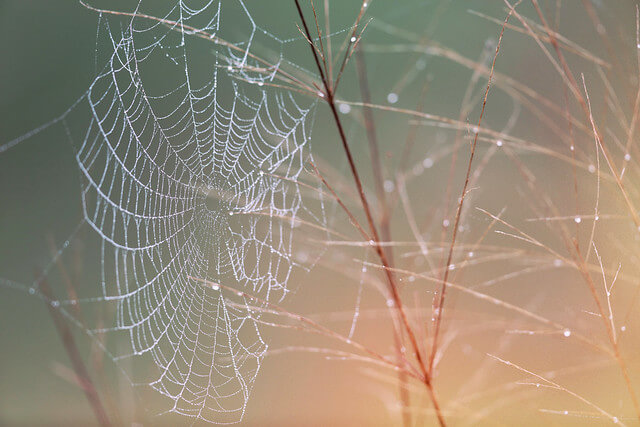How Spider Webs Can Detect Air Pollution
By Taylor Craig
Broadcast 6.2 & 6.7.2019

Photo by Lorie Shaull, CC 2.0.
Listen:
The sun was just starting to rise over the hills ahead of me as I sat looking into a pasture of tall grasses and flowers. As I peered through the fence, I couldn’t help noticing a vast array of spider webs. Each web was a perfectly crafted spiral with pearls of dew strung across it. Intrigued, I started to ponder what those webs caught and how they caught it.
I learned that these classic spiral webs are called orbs and are made by orb-weaving spiders. These spiders, like many others, weave their webs out of sticky strands of silk that make them deadly traps for flying insects. However, recent studies have shown that orb spider webs are also electrostatically charged, making them perfect for capturing not only prey but pollen and other small pollutants, which can indicate an environment’s health.
The electrostatic charge greatly helps the spiders capture prey. The webs are made of long strands of intertwined silk, and the compounds in the silk attract water molecules that will coat the entire web. It is this water that establishes a charge. The web then attracts any charged objects that come close to it. Many insects pick up a charge by flying through the air, just as your body becomes charged when you shuffle across the carpet in your socks. So, when an insect flies near a spider web, the stretchy, flexible silk strands will actually bend toward the insect and catch it. Depending on the size and charge of the prey, the web can move up to two millimeters toward it. Two millimeters is a huge distance compared to the thickness of the silk, which, on average, is ten times smaller. This improves a spider’s hunting success. There is some speculation that prey can sense the charge of a spider web as they near it, but by then it’s often too late.
The electrostatically-charged webs also catch pollen and small pollutants in the air. Just as insects do, particles in the air collect a charge as they move. And, just as they capture insects, the orb spider webs capture these minute particles. Large amounts of these particles, which include harmful aerosols and heavy metals from exhaust, can be detrimental to spiders, as they often ingest old or damaged webs before constructing new ones—and therefore ingest any substances caught in the web. Eating these harmful particles both impairs the spider’s ability to construct a successful web and decreases the number of captured prey.
Some current studies are analyzing the chemicals and pollutants caught in spider webs to determine the health of certain environments. The results show some of the impact humans are having on nature. One study collected webs based on their proximity to roads and busy highways and determined the amount of minute heavy metals caught on the silk. Another study is collecting spider webs from homes to analyze the health of our own living environments.
Who would have thought that orb spider webs are catching more than insects? Perhaps those webs that you see strung up in the nooks and crannies in your home will seem a little bit more beneficial from now on. You might even find yourself hesitating before swiping them away. Wouldn’t you love to know what they are collecting from your home?
Every week since 1991, Field Notes has inquired about Montana’s natural history. Field Notes are written by naturalists, students, and listeners about the puzzle-tree bark, eagle talons, woolly aphids, and giant puffballs of Western, Central and Southwestern Montana and aired weekly on Montana Public Radio.
Click here to read and listen to more Field Notes. Field Notes is available as a podcast! Subscribe on iTunes, Google Play, or wherever you listen to podcasts.
Interested in writing a Field Note? Contact Allison De Jong, Field Notes editor, at adejong [at] montananaturalist [dot] org or 406.327.0405.
Want to learn more about our programs as well as fun natural history facts and seasonal phenology? Sign up for our e-newsletter! You can also become a member and get discounts on our programs as well as free reciprocal admission to 300+ science centers in North America!












